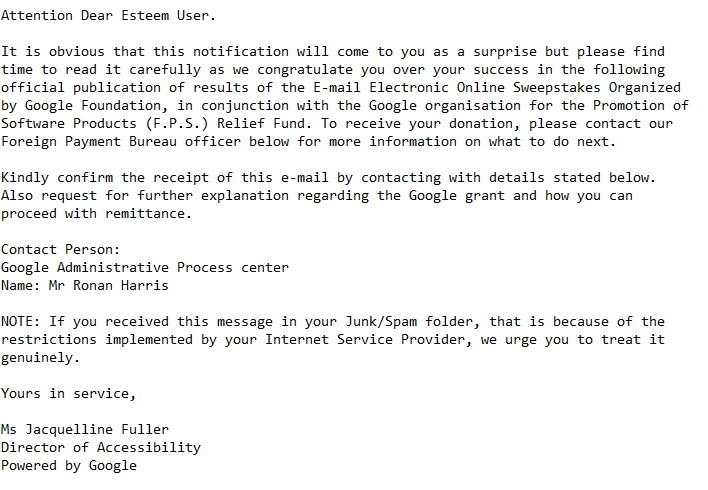“Google Foundation – E-mail Electronic Online Sweepstakes” email falls into the scam category. The email is supposedly from Google and informs recipients that they’ve been supposedly selected as a winner in an online sweepstakes. The sum recipients have supposedly won is not mentioned as users are instructed to contact another person to get more information. It goes without saying that this email is a scam, and its goal is to steal users’ personal information and money. Google also has nothing to do with it, its name is merely used to scam users.
This “Google Foundation – E-mail Electronic Online Sweepstakes” scam email congratulates users for being successful winners in something called E-mail Electronic Online Sweepstakes Organized by Google Foundation, in conjunction with the Google organization for the Promotion of Software Products (F.P.S.) Relief Fund. The user has supposedly won some kind of donation, though the sum is not mentioned in the email. It’s likely to be hundreds of thousands or even millions of dollars to trick users into engaging.
The email instructs users who want to receive the donation to contact Ronan Harris in Google’s Administrative Process Center. The email also provides a ridiculous explanation for why the email may have landed in the Spam folder. Supposedly, an email from Google was sent to the Junk folder because of restrictions implemented by users’ Internet Service Providers.
The text from the “Google Foundation – E-mail Electronic Online Sweepstakes” scam email is below:
Subject: Attention Dear Esteem User.
Attention Dear Esteem User.
It is obvious that this notification will come to you as a surprise but please find time to read it carefully as we congratulate you over your success in the following official publication of results of the E-mail Electronic Online Sweepstakes Organized by Google Foundation, in conjunction with the Google organisation for the Promotion of Software Products (F.P.S.) Relief Fund. To receive your donation, please contact our Foreign Payment Bureau officer below for more information on what to do next.
Kindly confirm the receipt of this e-mail by contacting with details stated below. Also request for further explanation regarding the Google grant and how you can proceed with remittance.
Contact Person:
Google Administrative Process center
Name: Mr Ronan HarrisNOTE: If you received this message in your Junk/Spam folder, that is because of the restrictions implemented by your Internet Service Provider, we urge you to treat it genuinely.
Yours in service,
Ms Jacquelline Fuller
Director of Accessibility
Powered by Google
If individuals interact with scammers and reply to their messages, they will likely be asked for a significant amount of personal information. Initially, scammers may ask for basic details such as full name, phone number, and home address, but as the conversation continues, they may request more sensitive information. Once scammers recognize that they have someone potentially interested, they will try to build trust, making the target more vulnerable.
When these scammers successfully obtain personal information, they often sell it to other criminals. Personal data is highly sought after, as it enables cybercriminals to launch more sophisticated and personalized attacks. Victims are more inclined to engage when approached by someone who knows their name and other specifics, increasing the chances of success.
Although obtaining personal information is important, the primary goal of such scam emails is to get money. Initially, these emails might not indicate this, but eventually, those who engage will be asked to send funds. Scammers typically come up with various reasons for needing money, such as claiming there’s an issue with a transaction that requires urgent financial assistance. While the explanations may seem nonsensical if viewed logically, established trust can lead recipients to comply with these requests.
It’s essential to highlight that emails promising money are always scams, especially those that offer unrealistic sums. Often, the content is so absurd that users don’t even need to scrutinize the emails to recognize them as fraudulent.
These email scams have been around for many years, and it’s surprising that people still fall for them. However, these campaigns require minimal effort and resources, allowing malicious groups to run them alongside other illegal activities.
If someone has already shared personal information with cybercriminals, they should exercise extreme caution with any unsolicited communications—be it emails or phone calls—in the future. Unfortunately, if someone has sent money, it is usually impossible to recover those funds. If they have given out their payment card details, they should immediately reach out to their bank to cancel their cards.
Why did you receive a scam email?
Malicious actors purchase email addresses from hacker forums and use them in their malicious campaigns. Therefore, users who receive scam emails in some forms likely had their email addresses leaked by some service they use. Users can check haveibeenpwned to see if their email address has been part of a data breach.
Site Disclaimer
2-remove-virus.com is not sponsored, owned, affiliated, or linked to malware developers or distributors that are referenced in this article. The article does not promote or endorse any type of malware. We aim at providing useful information that will help computer users to detect and eliminate the unwanted malicious programs from their computers. This can be done manually by following the instructions presented in the article or automatically by implementing the suggested anti-malware tools.
The article is only meant to be used for educational purposes. If you follow the instructions given in the article, you agree to be contracted by the disclaimer. We do not guarantee that the artcile will present you with a solution that removes the malign threats completely. Malware changes constantly, which is why, in some cases, it may be difficult to clean the computer fully by using only the manual removal instructions.
